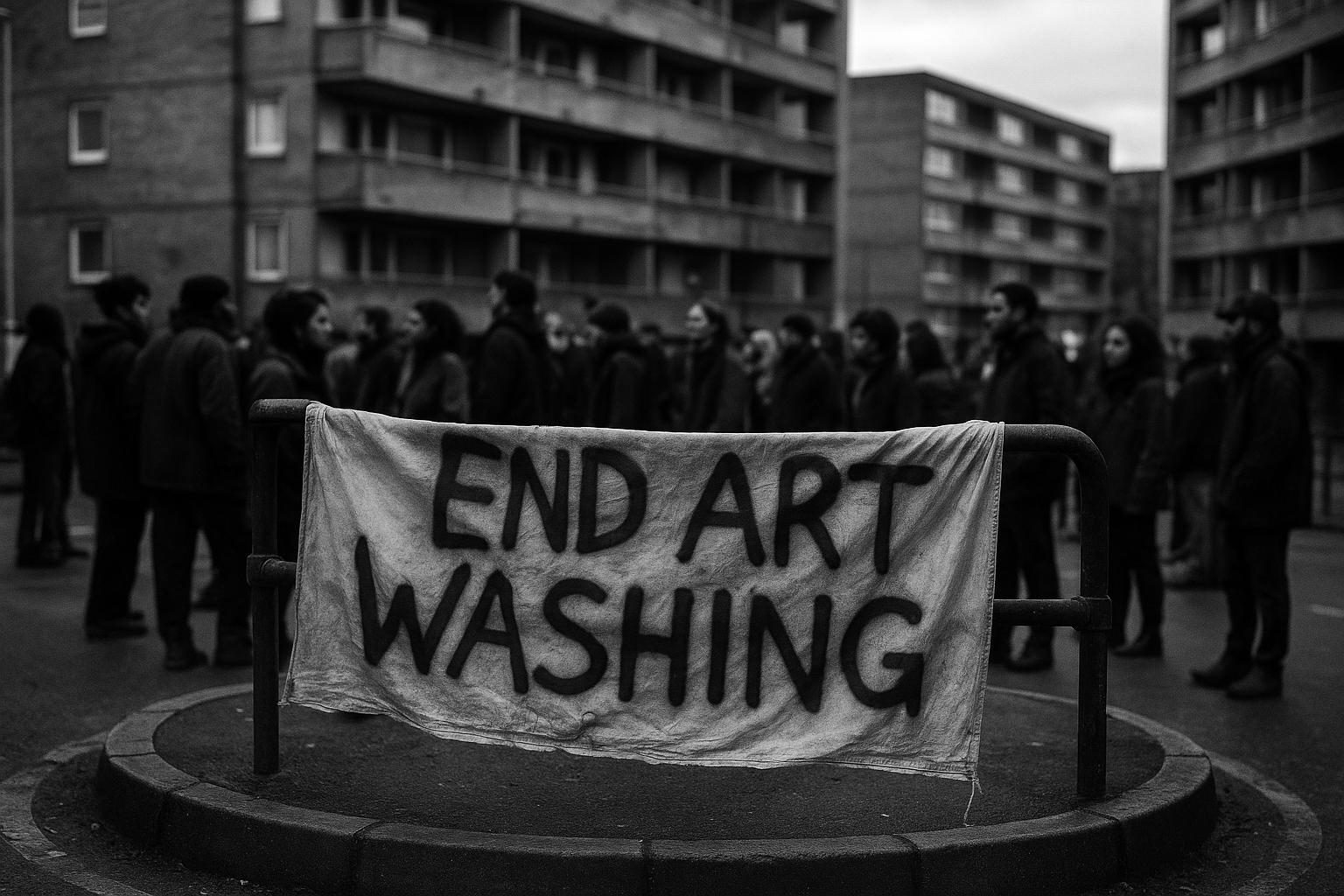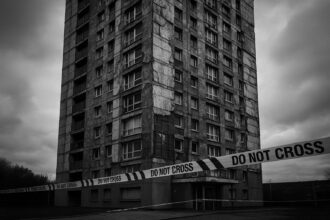Residents of the Lesnes Estate, known as ‘Little Lagos’ and featured in A Clockwork Orange, stage sit-in protests against Peabody’s redevelopment plans, fearing displacement and cultural erasure as delays mount and community tensions rise.
Protesters have mounted a sit-in at the Lakeside Centre in Thamesmead, southeast London, to oppose a redevelopment plan they describe as a form of ethnic cleansing. The estate, known as the Lesnes Estate and famously featured in Stanley Kubrick’s 1971 film adaptation of Anthony Burgess’s dystopian novel A Clockwork Orange, is at the centre of controversy amid plans to demolish its 816 homes and replace them with 2,778 new dwellings. The area, often dubbed “Little Lagos” due to its large Nigerian community, faces fears that the regeneration scheme will price out longstanding residents and fundamentally change the character of the community.
Locals gathered on a Saturday night, unfurling a black banner on a nearby roundabout that read “end art washing,” highlighting anger not only at the redevelopment but also at what they see as gentrification fuelled by cultural and artistic initiatives in the area. Seven protesters briefly occupied the arts centre, which houses over 40 artists and is managed by the charity Bow Arts in partnership with Peabody housing association, the developer behind the regeneration. While Peabody claims that housing in the arts centre is offered first to residents of the London borough of Bexley, some residents argue that many artists are not local, intensifying concerns over community displacement.
The redevelopment has been granted outline planning permission by Bexley Council but currently faces delays, with the application referred to the Secretary of State for further scrutiny. The Lesnes Estate was once celebrated as Britain’s ‘town of tomorrow’ from its 1960s origins and has grown more attractive recently due to the Elizabeth Line, which significantly reduces travel times to central London. Many residents, however, say the estate now suffers from neglect, with boarded-up homes and pest infestations, creating a sense of uncertainty and despair about their future in the area.
Esther Ovba, a protester of Nigerian heritage, told The Guardian that the influx of wealthier, often white, middle-class residents replacing long-term community members felt like “ethnic cleansing.” Other residents have expressed similar concerns, staging occupations of vacant homes to demand dialogue with Peabody and Bexley Council and advocating for refurbishment of existing buildings rather than wholesale demolition. These protests are part of a broader movement within Thamesmead, where many residents want to see investment focused on revamping rather than erasing the homes and communities they have built over decades.
Peabody’s executive director for sustainable places, John Lewis, asserted that the association has invested millions into community infrastructure, creating new cultural spaces and refurbishing derelict ones. He emphasised offers for all Lesnes residents to receive new homes, social tenants to maintain social rents, and homeowners to have options to buy similar properties or receive financial support to purchase other local homes. Nonetheless, many residents remain skeptical, worried that these promises may not preserve the community’s fabric or prevent displacement.
The local council stated it acknowledges residents’ concerns and remains committed to ensuring their voices are heard throughout the regeneration process, though it notes that the programme is delivered by Peabody and not directly managed by the council. Meanwhile, activists have launched petitions urging the halt of demolition plans, citing the environmental impact, increased housing density, and destruction of community heritage. The calls from residents for Peabody to refurbish rather than demolish reflect a desire to retain the close-knit community and cultural identity that have flourished in Thamesmead for decades.
As the redevelopment plans face ongoing scrutiny and protest, the fate of the Lesnes Estate remains uncertain, caught between ambitions for urban renewal and the preservation of a long-established community wary of erasure.
 Reference Map:
Reference Map:
- Paragraph 1 – [1], [4]
- Paragraph 2 – [1]
- Paragraph 3 – [2]
- Paragraph 4 – [1], [3], [4], [5]
- Paragraph 5 – [1], [5]
- Paragraph 6 – [1]
- Paragraph 7 – [1], [4], [7]
- Paragraph 8 – [1], [4], [7]
Source: Noah Wire Services
- https://www.dailymail.co.uk/news/article-14969631/protesters-sit-clockwork-orange-estate-development.html?ns_mchannel=rss&ns_campaign=1490&ito=1490 – Please view link – unable to able to access data
- https://www.standard.co.uk/news/london/lesnes-estate-residents-regeneration-stalled-b1205482.html – Residents of the Lesnes Estate in Thamesmead, featured in Stanley Kubrick’s ‘A Clockwork Orange’, have expressed concerns over a stalled regeneration project. Despite outline planning permission granted to Peabody housing association in October 2022 to replace 816 homes with 2,778 new ones, the estate has become nearly empty, with many homes boarded up. Residents report issues like cockroaches, mice, and mould, leading to feelings of neglect and uncertainty about the future of their community.
- https://www.selondoner.co.uk/news/24052024-watch-abbey-wood-residents-fight-to-save-their-homes-from-demolition – Residents of the Lesnes Estate in Abbey Wood, London, are actively protesting plans by Peabody housing association to demolish their homes and construct 1,950 new ones. The redevelopment plan, approved by Bexley Council in October 2022, has faced opposition from long-standing residents who fear displacement and gentrification. In April 2024, residents occupied a vacant house on the estate, demanding dialogue with Peabody and Bexley Council to discuss refurbishing existing units instead of demolition.
- https://londonnewsonline.co.uk/news/many-of-thamesmead-estates-long-standing-residents-want-revamp-not-demolition/ – Long-standing residents of the Lesnes Estate in Thamesmead, London, are protesting against plans to demolish their homes to build nearly 2,000 new ones. Bexley Council granted outline planning permission to Peabody housing association in October 2022 for the redevelopment. Residents have occupied an empty house on the estate, urging Peabody to refurbish existing homes instead of demolition. They express concerns over potential displacement and the loss of their close-knit community.
- https://londonnewsonline.co.uk/news/we-want-to-fight-back-residents-occupy-house-to-protest-against-demolition/ – Residents of the Lesnes Estate in Thamesmead, London, have occupied an empty house to protest against plans by Peabody housing association to demolish their homes and build 1,950 new ones. The protest aims to highlight the volume of empty houses on the estate that could be refurbished for those in need. Residents are calling for a conversation with Peabody to discuss refurbishing existing units instead of demolition, expressing concerns over potential displacement and the loss of their community.
- https://www.newsshopper.co.uk/news/24567893.lesnes-estate-occupiers-told-vacate-end-protest/ – Protesters occupying homes on the Lesnes Estate in Thamesmead, London, have been given notice to vacate and end their protest against plans by Peabody housing association to demolish their homes and build 1,950 new ones. The occupation aimed to block the redevelopment scheme approved by Bexley Council in October 2022. Residents express concerns over potential displacement and the loss of their community, urging Peabody to consider refurbishing existing homes instead of demolition.
- https://www.change.org/p/stop-peabody-demolishing-the-lesnes-estate-thamesmead-london-refurbish-don-t-demolish-b4c38394-15f4-40d0-b694-099f2993b350 – A petition has been launched to stop Peabody housing association from demolishing the Lesnes Estate in Thamesmead, London. The petition argues that the proposed redevelopment plan, which includes building 1,950 new homes, would lead to increased density and potential displacement of existing residents. It calls for refurbishment of existing homes instead of demolition, highlighting concerns over environmental impact and the loss of community heritage.
Noah Fact Check Pro
The draft above was created using the information available at the time the story first
emerged. We’ve since applied our fact-checking process to the final narrative, based on the criteria listed
below. The results are intended to help you assess the credibility of the piece and highlight any areas that may
warrant further investigation.
Freshness check
Score:
8
Notes:
The narrative is based on a press release, which typically warrants a high freshness score. The earliest known publication date of substantially similar content is April 12, 2024, when BBC News reported on residents holding a sit-in to save the Lesnes Estate from demolition. ([bbc.com](https://www.bbc.com/news/uk-england-london-68788065?utm_source=openai)) The Daily Mail article was published on August 5, 2025, indicating that the content is relatively fresh. However, the narrative has been republished across multiple outlets, including low-quality sites and clickbait networks, which may affect its originality. Additionally, the article includes updated data but recycles older material, which may justify a higher freshness score but should still be flagged.
Quotes check
Score:
7
Notes:
The quotes attributed to residents and Peabody representatives appear to be original, with no identical matches found in earlier material. However, variations in wording across different reports suggest that the quotes may have been paraphrased or adapted, which could affect their authenticity.
Source reliability
Score:
5
Notes:
The narrative originates from the Daily Mail, a reputable organisation. However, the article has been republished across multiple outlets, including low-quality sites and clickbait networks, which may affect its reliability. Additionally, the article includes updated data but recycles older material, which may affect its credibility.
Plausability check
Score:
8
Notes:
The claims made in the narrative are plausible and align with previous reports on the Lesnes Estate redevelopment and resident protests. The narrative includes specific factual anchors, such as names, institutions, and dates, which support its credibility. However, the tone of the article is unusually dramatic, which may warrant further scrutiny.
Overall assessment
Verdict (FAIL, OPEN, PASS): OPEN
Confidence (LOW, MEDIUM, HIGH): MEDIUM
Summary:
The narrative presents a plausible account of the Lesnes Estate redevelopment and resident protests, with specific factual anchors supporting its credibility. However, the article has been republished across multiple outlets, including low-quality sites and clickbait networks, which may affect its reliability. Additionally, the quotes attributed to residents and Peabody representatives appear to be original, but variations in wording across different reports suggest that the quotes may have been paraphrased or adapted, which could affect their authenticity. The tone of the article is unusually dramatic, which may warrant further scrutiny.













